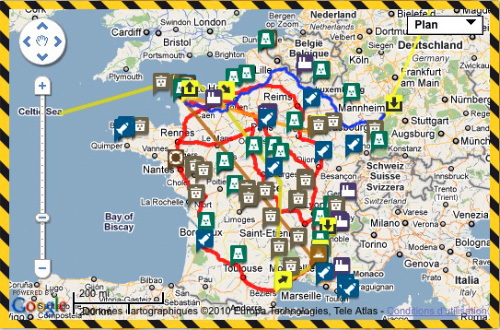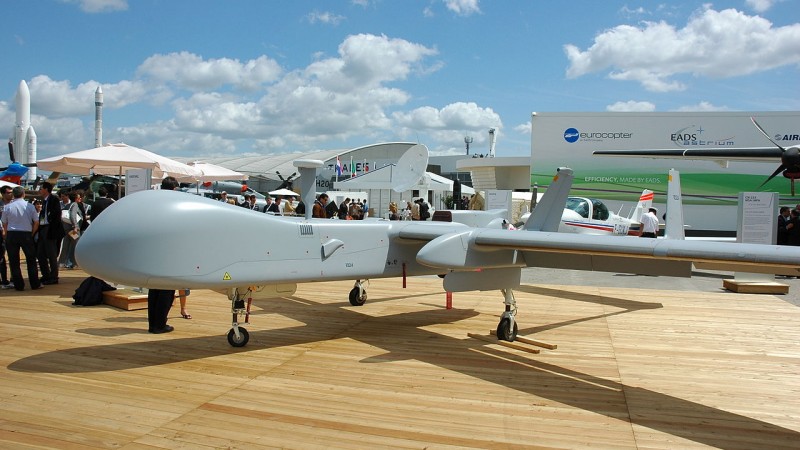[Most links are to French-language articles]
At least 19 drones have been spotted in the past two months flying over nuclear power stations in France. So far, no one has claimed responsibility for conducting these flights. French electric utility company EDF says the drones pose no risk whatsoever to the plants’ equipment or operations, but many nationwide are still uneasy.
With 58 nuclear reactors spread out over 19 plants, France is the highest user of nuclear energy in Europe, and the second highest in the world, after the United States.
In a blog post published on the website Géneration NT, Jérôme G. gives some insight into the matter:
Les drones de loisir permettent de prendre des images saisissantes à basse altitude. C'est un spectacle de nature bien différente lorsque des drones survolent des centrales nucléaires, d'autant qu'il pose la question de la sécurité. Avec la peur ambiante du terrorisme, la crainte que des drones porteurs de charges explosives survolent de tels sites sensibles n'est pas loin.
Depuis le début du mois d'octobre, les équipes de surveillance de EDF ont repéré les survols de sept centrales nucléaires par des engins dits assimilables à des drones. La France compte 58 réacteurs nucléaires répartis sur 19 centrales.Parfois le même jour, les centrales survolées ont été celles du Blayais (Gironde), Bugey (Ain), Cattenom (Moselle), Chooz (Ardennes), Gravelines (Nord), Nogent-sur-Seine (Aube), ainsi que la centrale en déconstruction de Creys-Malville (Isère).
Recreational drones allow users to take arresting images from a low height. It is another story altogether, however, when drones fly over nuclear power plants, especially since it raises questions about security. With concerns about terrorism ever-present, the fear that drones carrying explosive devices could potentially fly over such sites looms large.
Since the beginning of October, surveillance teams from EDF have noted seven that devices that look like drones have flown over seven nuclear plants. France has 58 nuclear reactors distributed throughout 19 power plants.
The plants that were flown over are Blayais (in the department of Gironde), Bugey (in Ain), Cattenom (in Moselle), Chooz (in Ardennes), Gravelines (in Nord), and Nogent-sur-Seine (in Aube), as well as the plant currently being dismantled in Creys-Malville (in Isère). Sometimes, the incidents occur on the same day.
Drones have successfully evaded all the power stations’ defenses. EDF also reports a number of drone overflights that differs from Greenpeace's count. Pascal Riché, co-founder of rue89.nouvelobs.com, notes:
EDF cite sept centrales survolées:
- Creys-Malville (Isère) ;
- Gravelines (Nord) ;
- Cattenom (Moselle) ;
- Blayais (Gironde) ;
- Bugey (Ain) ;
- Chooz (Ardennes) ;
- Nogent-sur-Seine (Aube).
Selon Greenpeace, trois autres sites sont impliqués :
- le CEA à Saclay (Essonne) ;
- la centrale nucléaire de Fessenheim (Haut-Rhin) ;
- le site d’Areva de Pierrelatte, dans le complexe de Tricastin (Drôme).
EDF lists seven power plants that have been flown over :
- Creys-Malville (Isère)
- Gravelines (Nord)
- Cattenom (Moselle)
- Blayais (Gironde)
- Bugey (Ain)
- Chooz (Ardennes)
- Nogent-sur-Seine (Aube)
Greenpeace reports that these three have also been involved:
- CEA at Saclay (Essonne)
- the nuclear power plant at Fessenheim (Haut-Rhin)
- the plant at Areva de Pierrelatte, located in the Tricastin complex (Drôme)
Greenpeace has protested in Europe many times before. In 2012, the organization flew a drone aircraft over a nuclear power plant in the Hague and piloted a manned paramotor over France's Bugey Nuclear Power Station, intending to discredit public claims by EDF and the French authorities that the stations pose no threat to human beings.
Greenpeace denies any role in the more recent drone sighting, however, reminding the public in several press releases that it always acts openly and claims responsibility for its acts.
On November 24, 2014, Greenpeace commissioned a confidential report by a British firm about the vulnerabilities of France's nuclear power stations—vulnerabilities to attacks and incursions by drone aircraft. Greenpeace says it sent copies of the report to state authorities in Germany, Belgium, and Luxembourg.
Audrey Oeillet, a journalist who describes herself a “geekette” first and foremost, wrote about the report for clubic.com, where readers left several heated comments. One reader, “ManuKey,” applauded Greenpeace:
Une fois de plus, bravo à Greenpeace pour avoir soulevé cette question!
Once more kudos to Greenpeace for raising this question!
Greenpeace une bande de cons qui grace au nucleaire peuvent se rechauffer et avoir de la lumiere et qui peuvent dire merci aux sociétés petroliere pour mettre de l'essence dans les bateaux et zodiac… me feront toujours rigoler les ecolos par l'hypocrisie qu'ils possedent
Greenpeace a gang of fools that—thanks to nuclear energy—can stay warm and have light. They have oil companies to thank for fueling their boats and zodiac [sic]… these eco-freaks will always make me laugh with their hypocrisy.
Cela étonne qu’avec nos moyens actuels les forces militaires ne puissent détecter ces drones ? Moi pas, les budgets de ces corps de métier sont en baisses et pas qu’un peu, chaque peloton exécute des ordres et même si l’ordre de tirer à été donné cela reste à vérifier.
Pas sûr non plus qu’il y ait beaucoup de détecteurs de drônes. Alors des gendarmes qui patrouillent quotidiennement pour la surveillance de ces sites nucléaires, oui, mais maintenant je ne vois pas trop en quoi cela va permettre de partir à leur chasse que ce soit de ces objets volants ou des propriétaires.
Isn't it surprising that, with all our modern capabilities, our military forces cannot track down these drones? Funding for these lines of defense are declining—and not just a little. There's also an excess of red tape with even routine maneuvers.
It is also unclear if many drone detectors exist. Sure, we have police that patrol each day as part of surveillance measures at these nuclear sites, but I can't really see how that is going to help them hunt down these objects—whoever owns them.
On November 5, Rémi Barroux and Audrey Garric co-authored an article in Le Monde, “What Threats Do Drones Pose to Nuclear Power Plants?”
Readers left many interesting comments, some of which were quite alarming. One commenter writes:
Je travail dans la sécurité informatique. Un drone peu très bien avoir été envoyé dans l'unique but de déposer au sol une clé usb dans laquelle se trouve un virus. Quiconque trouvera la clé peut la prendre et potentiellement infecter la central.
I work in IT security. A drone could very well have been sent with the sole purpose of dropping a USB key containing a virus. Whoever finds that key could take it and possibly infect the plant.
Another reader, Pierre Guillemot, describes a personal experience that is far less amusing:
Témoignage personnel: je suis entré en voiture dans la centrale de Saint-Laurent-des Eaux près d'Orléans, au mois de juin vers 20h (de jour). J'ai franchi 3 postes de garde déserts, barrière relevée. Arrivé près des réacteurs, j'ai garé ma voiture. Un agent en uniforme m'a demandé de la déplacer car elle était sur un emplacement réservé. Je me suis promené à pied. Comme l'heure s'avançait, je suis ressorti. Personne ne m'a posé de questions. Certes, c'était l'été 2001. Sécurité ?
Personal account: one day in June at around 8 pm I drove into the plant compound at Saint-Laurent-des Eaux near Orleans. I passed 3 deserted guard booths with the barriers raised. I got near to the reactors and parked my car. A uniformed agent asked me to move it because it was in a reserved parking spot. I walked a few rounds on foot. It got late, so I left. No one asked me any questions. This was the summer of 2001… what security?
In a press release, dated November 3, the General Secretariat for Defense and National Security, a service that reports directly to the Prime Minister, announced that the government will not issue any detailed statements about surveillance, detection, or protection measures now in place at nuclear power facilities. Whatever the state's defense measures, a Greenpeace activist was recently able to photograph a high-tech military radar stationed near two nuclear power plants in France. This device, experts say, is the only kind of equipment capable of detecting drones.










10 comments
Probably just a coincidence but:
– “Russian Fascist Aleksandr Dugin Gathering Intelligence on the French Military”: http://www.interpretermag.com/russian-fascist-aleksandr-dugin-gathering-intelligence-on-the-french-military/
“Whoever takes the key could possibly infect the plant…” How does the author imagine that? A plant employee finds a USB key on the ground, brings the key to his/her office, plug the key into the computer… Why would he/she do it?
Another question: how can a drone flying over a power plant “discredit claims that power plants pose no threats to human beings”. Did the drone measure the level of radiation above the plant, or take air samples?
Lack of security- that’s a real issue, as it follows from Pierre Guillemot’s twitter. Anybody can drive a car near to reactors! Fortunately, there was a Pierre in the car and not…somebody else.
”I work in IT security. A drone could very well have been sent with the
sole purpose of dropping a USB key containing a virus. Whoever finds
that key could take it and possibly infect the plant. ”
So… the facility personnel is TRAINED so that if somebody finds an USB Flash stick on the ground, goes quickly to the nearest computer inside the nuclear plant, plugs it in and, as fast as humanly possible, executes each and every file found on that stick.
What if there are ”drones” that measure radiation? From Greenpeace, from the facility itself, from concerned citizens. It does not matter.
First, if a ”drone” gets irradiated by some leakage, big deal! In the worst case scenario there is a few hundred dollars loss in components. If an employee or several get irradiated in a leakage, there is a real tragedy and nothing could ever compensate that.
Second, if a ”drone” malfunctions, is lost, crashes, inside that power plant, there will be only the owner of the device that will feel any losses. There is no way that an external object can jeopardize a nuclear power plant. These facilities are built in a safe and secure manner, not like your average enterprise HQ or a regular house. They are built to withstand earthquakes, tsunamis, hurricanes, whatever nature can throw and mankind can’t replicate even with it’s worst weapons.
We wouldn’t have nuclear power at all if the plants could be threaten by a kilogram of flying carbon fiber. It’s like if a seagull takes a dump inside a cooling tower and the whole shebang shuts down because of that.